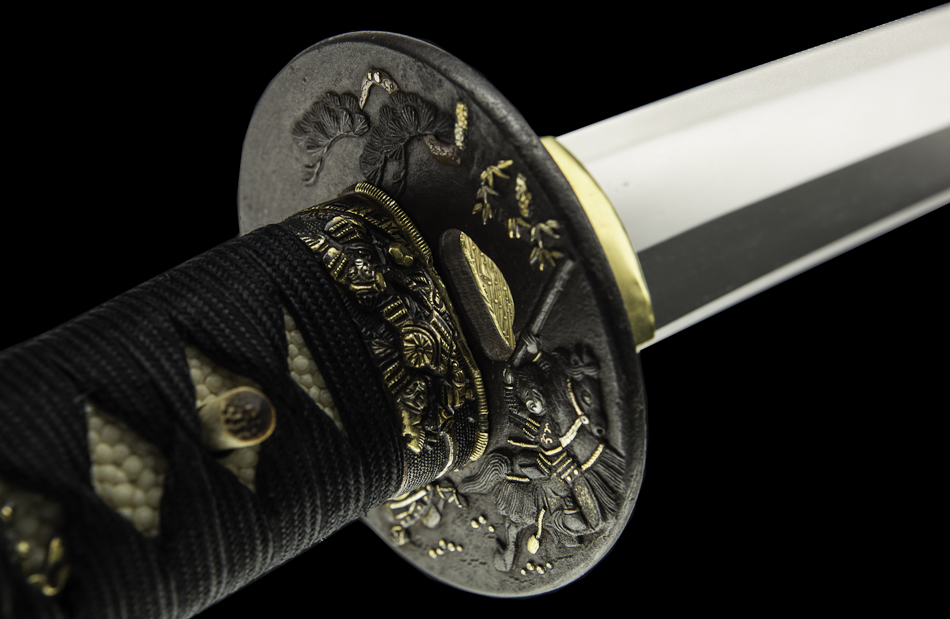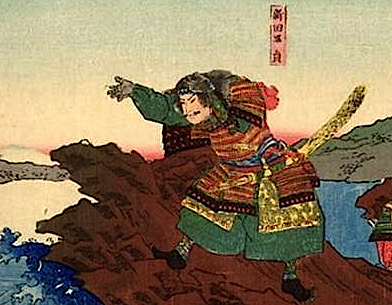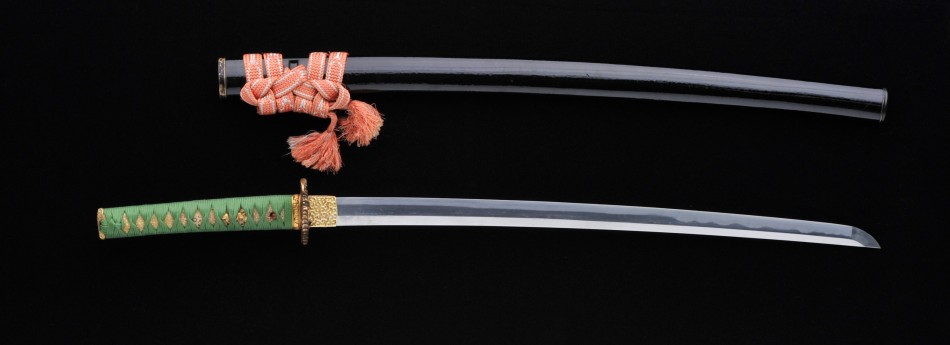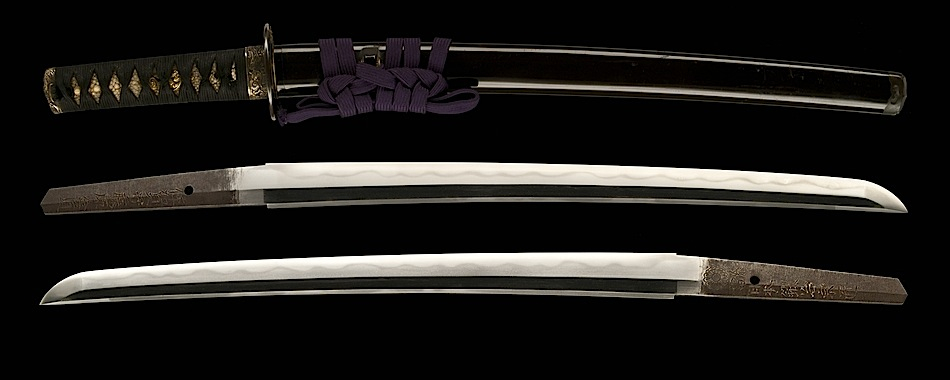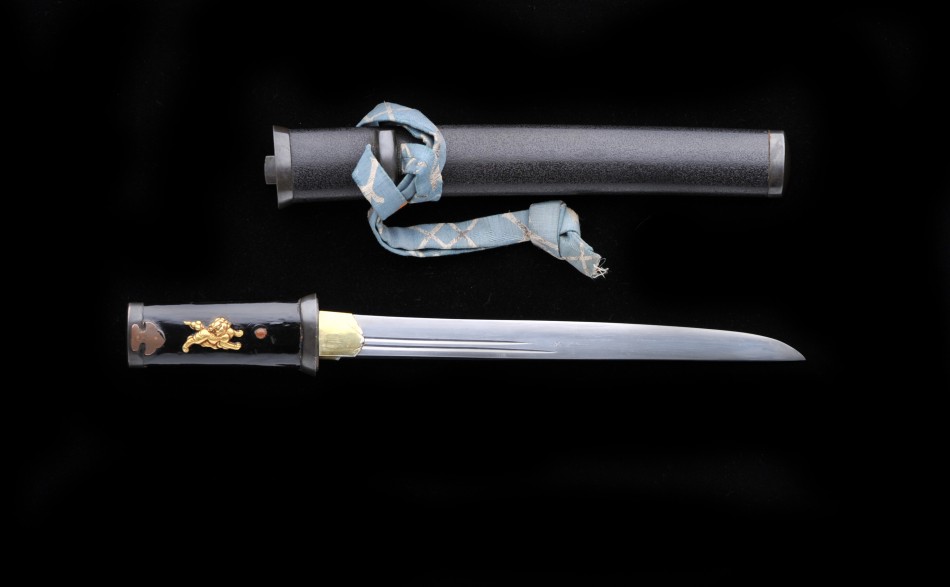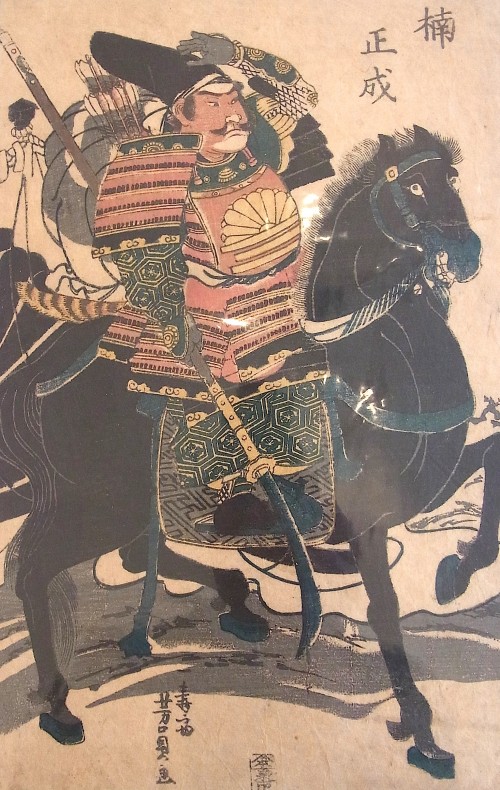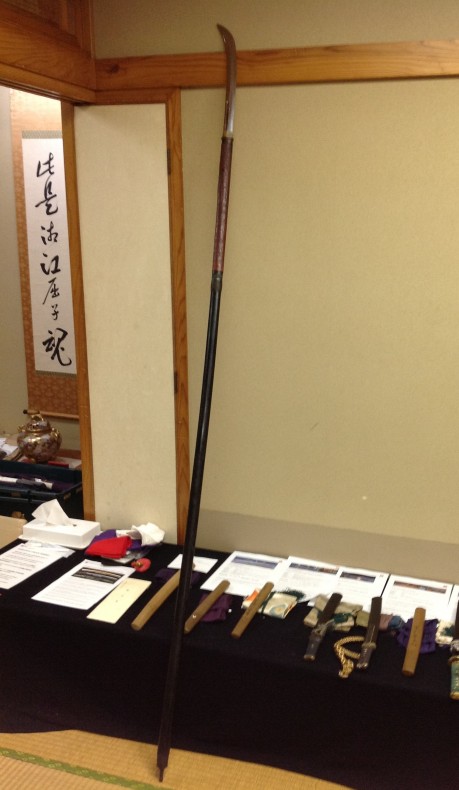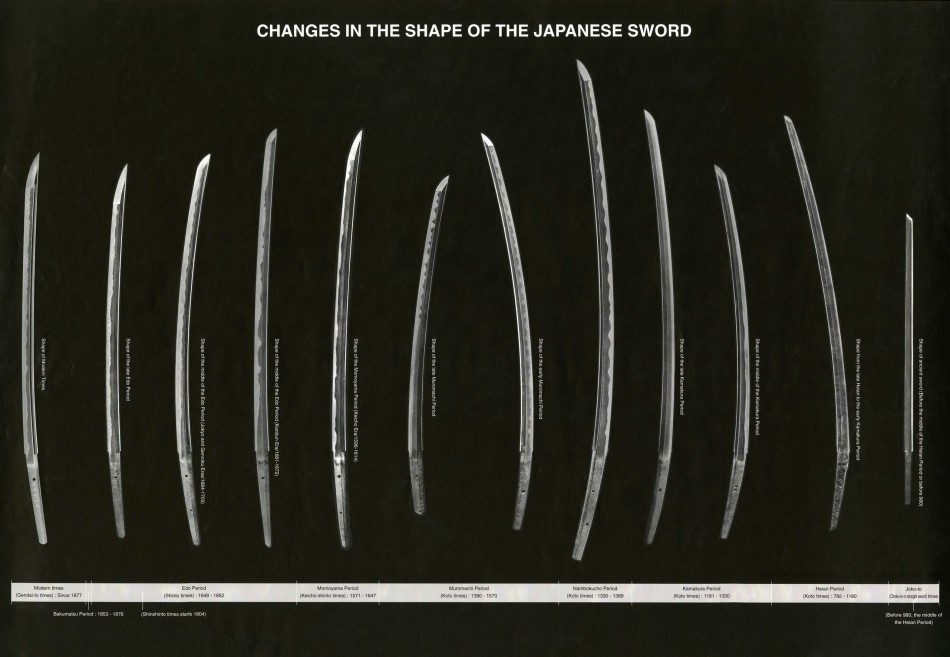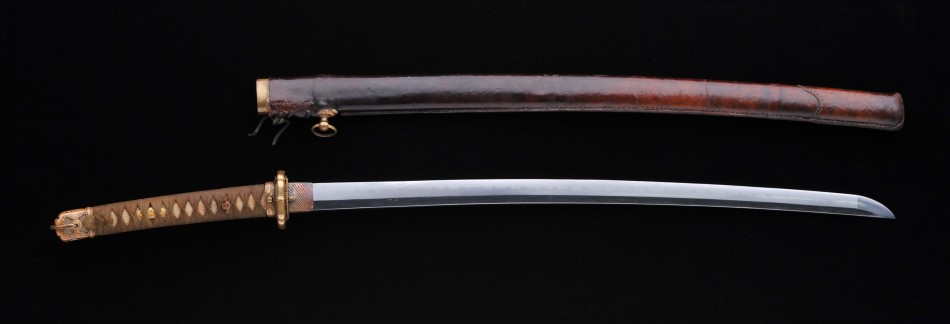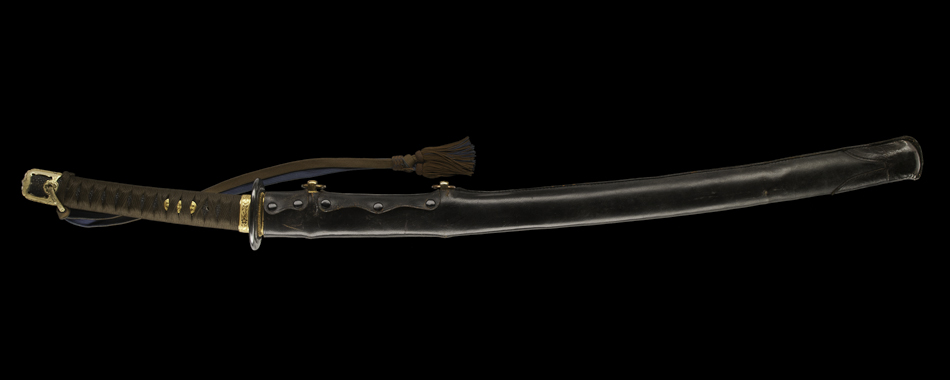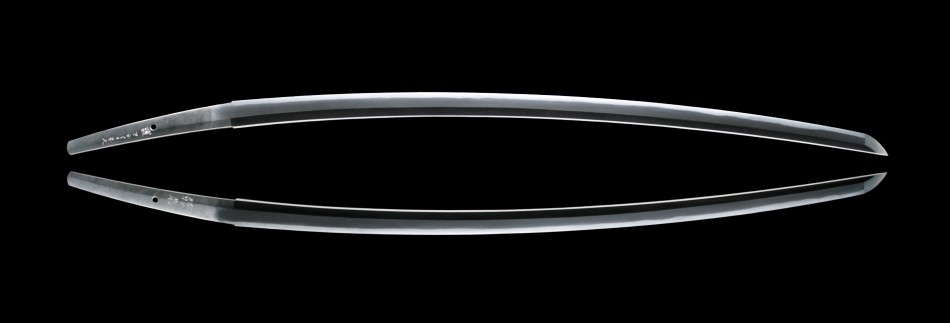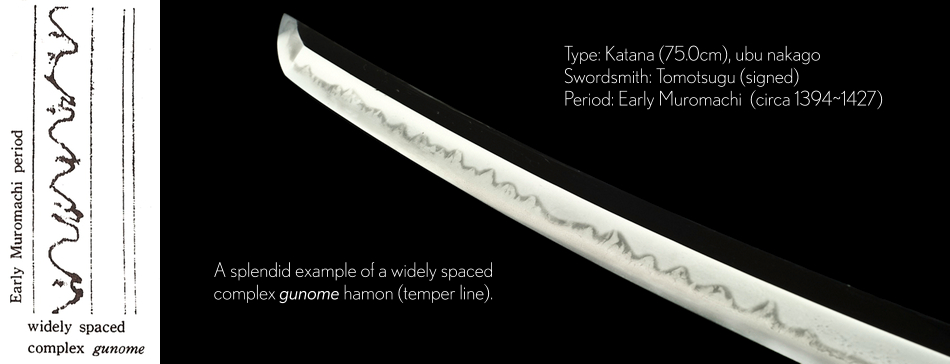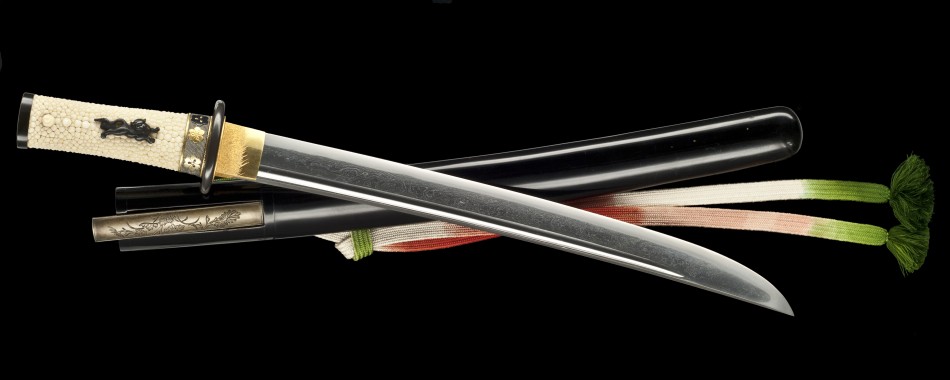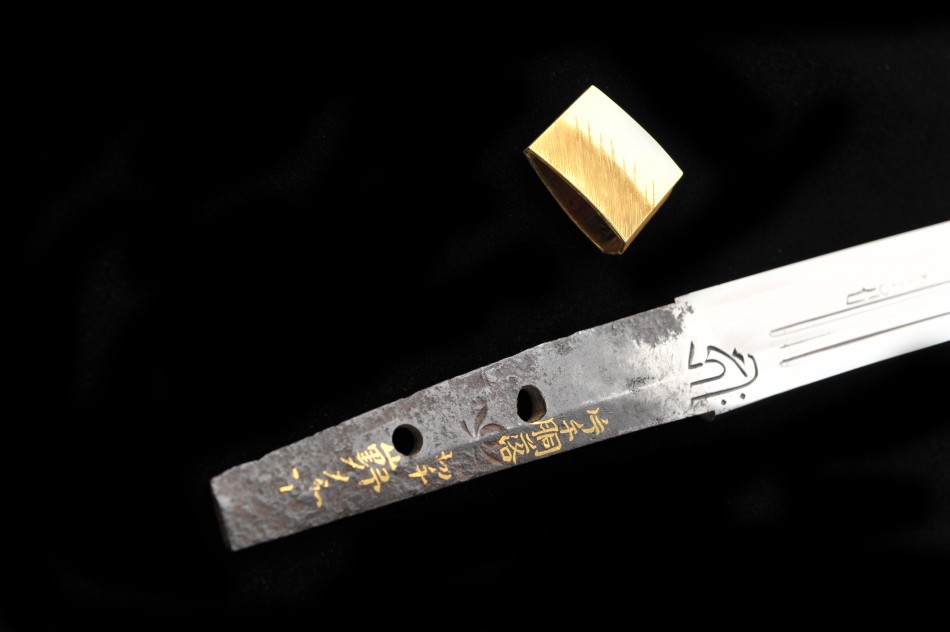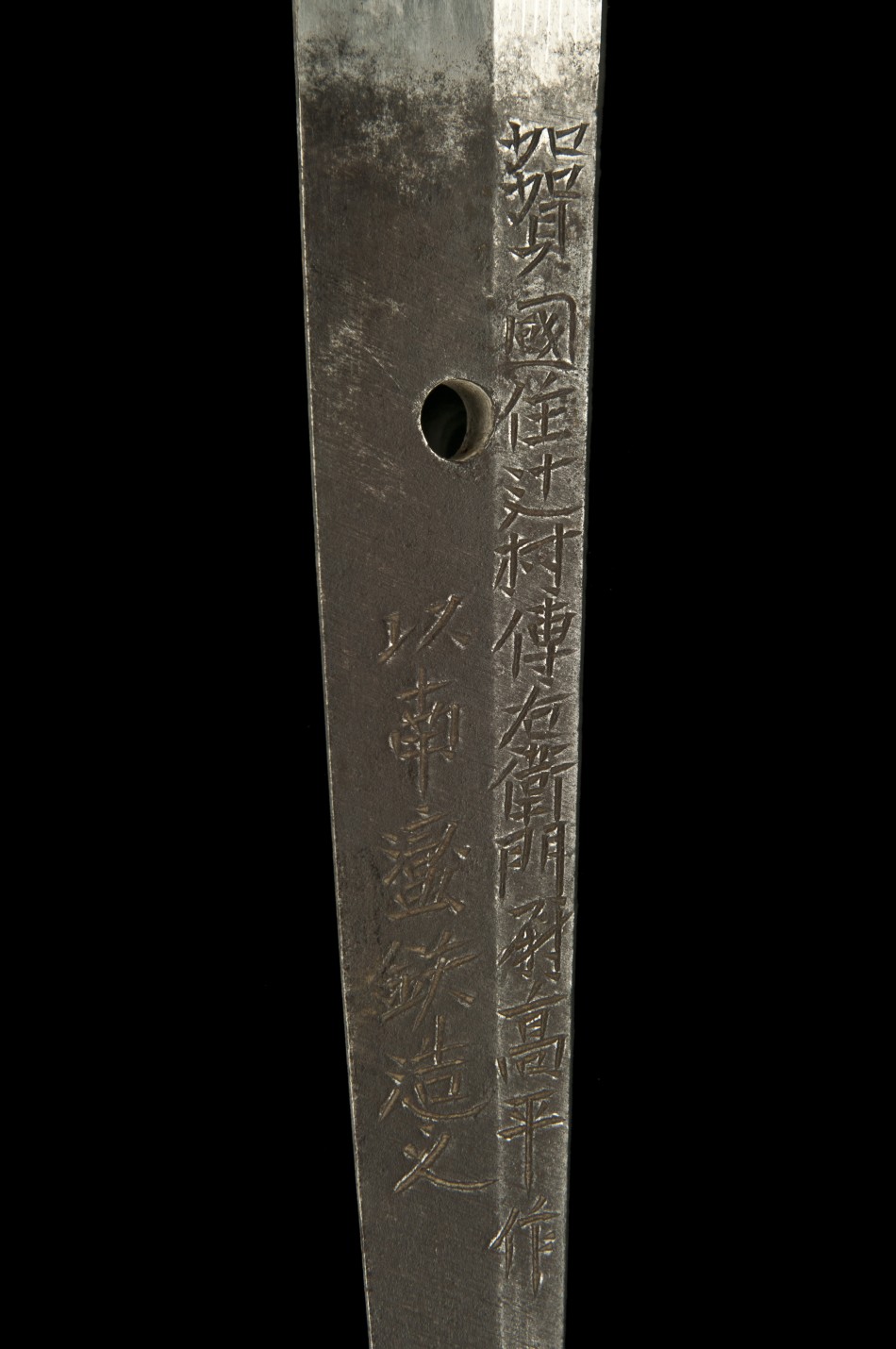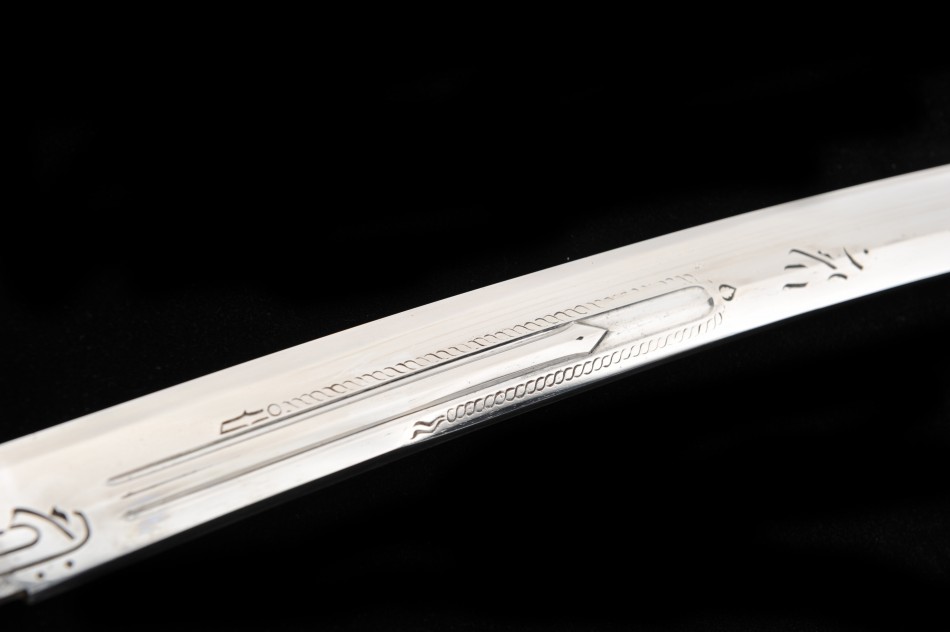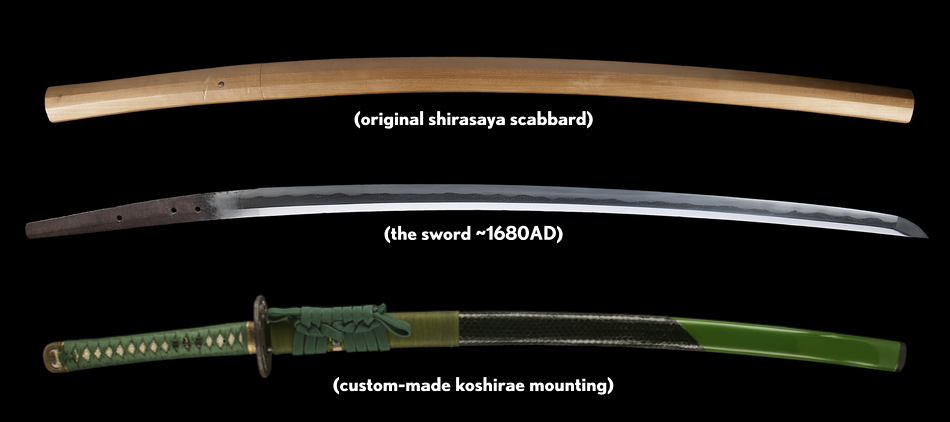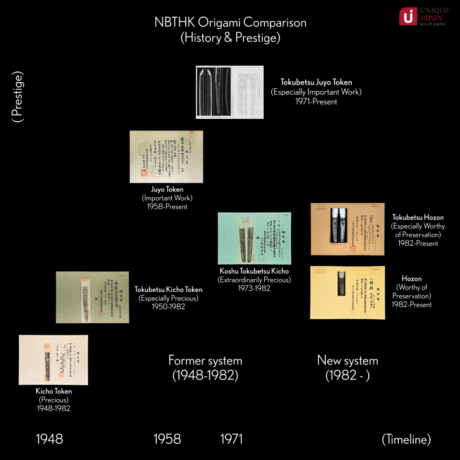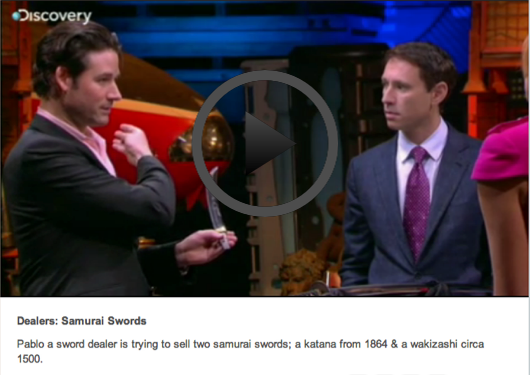7 Points to Consider when Choosing Your Japanese Sword
QUICK MENU
Preface: OWNING A JAPANESE SAMURAI SWORD
Point 1: THE SWORD, THE SOUL OF THE SAMURAI
Point 2: TYPE OF SWORDS
Point 3: WHEN IT WAS MADE
Point 4: BUDGET
Point 5: THE STEEL AND ITS STRUCTURE
Point 6: SWORD MOUNTINGS (KOSHIRAE)
Point 7: CERTIFICATION (ORIGAMI) PAPERS
Preface: OWNING A JAPANESE SAMURAI SWORD
Point 1: THE SWORD, THE SOUL OF THE SAMURAI
Point 2: TYPE OF SWORDS
Point 3: WHEN IT WAS MADE
Point 4: BUDGET
Point 5: THE STEEL AND ITS STRUCTURE
Point 6: SWORD MOUNTINGS (KOSHIRAE)
Point 7: CERTIFICATION (ORIGAMI) PAPERS
Preface: Owning a Japanese Samurai Sword
Hello. My name is Pablo, founder of Unique Japan. It’s a great pleasure to welcome you.
I’m happy that you found this article because I’d like to take this opportunity to share with you factual insights and personal thoughts into the most iconic symbol of Japan’s culture, the Samurai sword.
The first question I often receive about Japanese swords is one based more on disbelief…“Can I really own a Japanese sword that is over 500 years old and have it shipped home?”
Yes, it’s true. And to be honest, even after having lived in Japan for 10 years I had no idea it was possible.
But once I became a collector of Japanese swords, the lasting impact it has had on my life (and subsequently on the lives of our clients) has been truly profound.
It’s a little hard to explain, but a sword carries a sense of calmness, of focus, of limitless admiration. An object with a level of detail and dedication so extraordinary that it’s impossible to not be inspired each and every time you hold one in your hands.
A genuine Japanese sword really does represent all that what makes Japan special. The Samurai sword is Japan.
Many Great Questions
When clients contact us at Unique Japan interested in becoming an owner of an antique Samurai sword, a great range of questions always come pouring in:
Which swordsmiths are considered to be the best?
How much do they generally cost?
Can you provide a certificate of authenticity? (yes, this is possible)
Which swords typically gain the most value over time?
How many folds are in a typical Japanese sword?
Who exactly were the Samurai?
I heard that it was impossible to own a genuine Japanese sword? (not true, only about 100 national treasures cannot leave the country)
What key points should I look for when I invest into a Japanese sword?
How do I best display the sword in my home?
What is the difference between a katana and a wakizashi?
Did Hattori Hanzo (from Kill Bill) really exist?! (well, yes and no ;)
What should I be careful of when buying a sword?
How much do they generally cost?
Can you provide a certificate of authenticity? (yes, this is possible)
Which swords typically gain the most value over time?
How many folds are in a typical Japanese sword?
Who exactly were the Samurai?
I heard that it was impossible to own a genuine Japanese sword? (not true, only about 100 national treasures cannot leave the country)
What key points should I look for when I invest into a Japanese sword?
How do I best display the sword in my home?
What is the difference between a katana and a wakizashi?
Did Hattori Hanzo (from Kill Bill) really exist?! (well, yes and no ;)
What should I be careful of when buying a sword?
Lots of interesting, thoughtful questions, of which and I once had (and still have!) myself. And I love answering them! A Japanese sword is no small investment, and we all want to make the best decision of what’s right for us.
And such is the purpose of this article. I want to SHARE with you an overview of what I have learned over the years from my mentors in Japan (and continue to learn from), and my fellow collectors, from books and also from our valued clients.
It is my sincere wish that this article is helpful and inspiring. Consider it a jumpstart to the world of collecting Japanese swords. And what an awe-inspiring world it is!!
Your Personal Connection to Japan
Before I begin the seven points, I’d like to first address the very notion of owning a Japanese sword itself.
I first travelled to Tokyo from Montreal, Canada in November 1993, and up until 2011 made it my (our) home. Spending almost 20 years in the country was a personal experience that my family and I won’t ever forget. Thankfully I still travel back to Japan numerous times a year.
All of our clients share a personal connection and history with Japan. They may have lived in the country for a few years, worked with Japanese companies, have a family member who is Japanese, studied a martial art, or simply have had an enduring admiration for Japanese culture.
Everyone has their own special story with Japan.
And in my opinion, this personal connection is important. The sword becomes a symbol of their unique relationship with Japan and the people from Japan. It truly stands for something significant in their lives.
Purity and Perfection
A Japanese sword is a pure object made up only of nature’s elements; earth, fire, wind, water, and constructed by human hands and spiritual energy.
In NO OTHER culture has the sword been developed to such a level of technological excellence and attained such a position of spiritual importance as in Japan. A Samurai sword is certainly Japan’s most-prized keepsake.
And to think a Japanese sword was essentially perfected back in MID 900AD!
That wasn’t a misprint… For more than 1,000 years, swordsmiths to this very day aim to recreate works of art to the level of masterpieces forged during the Heian (794-1185) and Kamakura period (1185-1333).
It is utterly amazing…
In this modern world so heavily influenced by the latest technology, here is an art form that needs not necessarily to be ‘improved’.
It’s an art form that exists to be cherished and respected for generations. And it holds a philosophy to live by.
A Symbol of the Modern-Day Warrior
The finest definition I’ve read for the word ‘warrior’ is “one who conquers oneself.”***
In other words, a warrior is a master at handling life’s problems and overcoming any obstacle.
In other words, a warrior is a master at handling life’s problems and overcoming any obstacle.
Warriors DON’T LET FEAR, in whatever shape or form, stop them. A warrior is completely unstoppable.
Over the years I have come to recognise a definite pattern emerge within the extensive range of clients we’ve had the honour to serve. A common personality trait that relates to the Samurai and his coveted sword.
In my opinion, this personality trait is the sense of commitment.
An overwhelming commitment to their own personal growth. And more importantly, a COMMITMENT TO ADDING VALUE to society. This is a powerful mind-set towards a higher sense of self that leads to a greater strength of character, attitude and a more prosperous world around us.
No matter what your profession; be it a member of the Armed Forces, a medical doctor, a pilot, an entrepreneur, a police officer, a corporate executive, a solicitor, an investment banker, an actor, a musician, a computer programmer, a professional athlete – owning a Samurai sword is a symbol of the modern-day warrior and his or her commitment to a life filled with COURAGE, PURPOSE and ADDING VALUE.
I’ve written an article “7 Reasons WHY I love Japanese swords“, that dives a little deeper into this subject that you may find interesting:
https://new.uniquejapan.com/7-reasons-why-i-love-japanese-swords
https://new.uniquejapan.com/7-reasons-why-i-love-japanese-swords
Japanese Swords, it’s ALL in the Details.
A Japanese sword is one such object that offers a life of endless discovery. The amount of detail that goes into its making is nothing short of a tiny miracle.
Each sword has it’s own unique personality.
Just as everyone has a unique mission in his or her own life.
A team of craftsmen dedicating their lives to its perfection. A finished object that will last hundreds and hundreds of years.
Everyday these craftsmen honed their skills, and they improved little by little. They dove headfirst into their craft and they never looked back.
This attention to detail translates to a genuine APPRECIATION FOR LIFE. A credo that the Samurai lived by.
The razor-sharp edge of a Japanese sword serves as a reminder to appreciate the magnificence, fragility and beauty of life itself.
As swordsmith Kawachi Kunihira once said:
“It’s not because a Japanese sword is beautiful that it can cut,
it’s because it can cut that makes it beautiful.”
it’s because it can cut that makes it beautiful.”
Forever Lasting Memories
It’s comforting to know that a Japanese sword will essentially live on forever. Long after we are gone and missed.
To know that our children, and generations that follow, can cherish and preserve a memory of ours that holds such spiritual importance. Memories that embody the values we stood for, the accomplishments we made, and the value we helped contribute to this world.
Below are seven points that have been highlighted to consider when choosing your personal Japanese sword.
Please remember we can be contacted with any questions or concerns you have.
It will be our absolute honour and pleasure to serve you.
Point 1: THE SWORD, THE SOUL OF THE SAMURAI
Swords play a central role in Japanese tradition and are widely admired for their elegance, beauty, technical excellence and spiritual qualities.
In Shinto, the Shintai or ‘Body of Kami (spirit)’ can be found in a stone, tree, river, mountain or a human made object such a sword or a mirror. A mirror reflects the light of the sun, which is revered as the highest divine power for the sensible reason that it is the source of all life on the planet.
Swords are frequently used as objects of spiritual healing as their power and beauty make them ‘yorishiro’, objects that by their very nature attract a sacred energy.
As Michihiro Tanobe, former Senior Managing Director of the Society for the Preservation of the Japan Art Sword (NBTHK) writes:
“The Japanese people have traditionally expected objects to have artistic beauty in addition to practical excellence and the pursuit of beauty in all spheres of activity has always been inherent in their nature.
Iron is a material with a shiny and cold quality but the Japanese were able to give it life and make it bloom as an artistic object.”
Gaining an understanding of who the fearless Samurai were and what their sword represented to them is of vital importance.
Samurai warriors were the elite of four classes of Japanese feudal society (1185-1868);
Samurai – Warrior Class
Second class – Farmers
Third class – Craftsmen
Forth class – Merchants
The term, Samurai, is a derivative of the Japanese verb for service, “saburau” (SA-BOO-RA-OH). Samurai literally means “one who serves”, and that is how they began, SERVING AND PROTECTING the imperial family and subsequently other lords.
During the Edo Period (1600-1868), the Samurai were expected to PROTECT members of the other three classes.
Samurai were inspired by Bushido “Military-Knight-Ways” is an unwritten code of moral principles which the knights (Samurai) were required or instructed to observe.
Not merely fighters, the Samurai were also dedicated and inspired men of culture. In short, the Samurai were a class act.
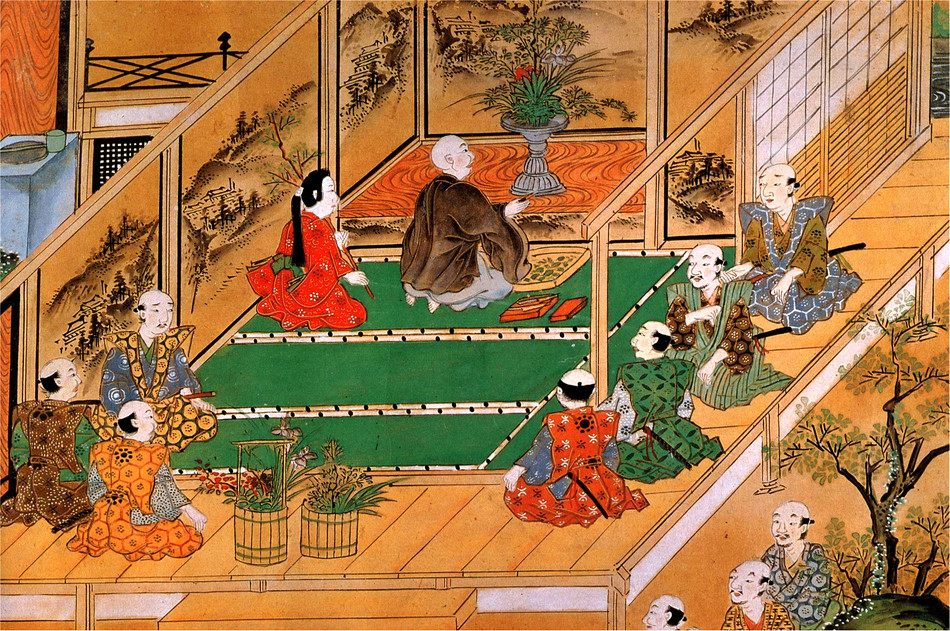
Above is an Ukiyo-e woodblock print of Japanese Samurai performing and admiring Ikebana (The art of Japanese flower arrangement)
Bushido made the sword its emblem of power and spirit. The very possession of such a valuable instrument imparts to him a feeling and an air of self-respect and responsibility. What he carries in his belt is a symbol of what he carries in his mind and heart – loyalty and honour.
The term 士道 Shido means “The Way of the Samurai.” The ultimate warriors’ code of honor, the Way of the Samurai is to “protect your truth.” Never betray yourself. A Samurai would choose death over living with an untrue heart. **
Often, the second son was born into a life of warfare, as the first son was needed to take care of the family household. As part of his training, a Samurai warrior considered it “his foremost concern to keep death in mind at all times.” Doing so, will fulfill the ways of loyalty and familial duty.
A true Samurai was never loud, boastful or a braggart. This type of character was reserved for those of lower stature. A Samurai was modest, independent and appreciated the beauty of life. A quiet character perhaps; certainly one with a silent intensity unlike any other.
Their sword embodied such commitment, a legacy, a vessel for their enduring soul.
Perhaps most significantly, the Samurai lived for the day, for this very moment.
As Tokugawa Ieyasu (founder and first shogun of the Tokugawa shogunate of Japan in the early 17th century) famously said, “The Sword is the Soul of the Samurai.“
Point 2: TYPE OF SWORDS
The western world is generally familiar with the long katana that one sees in movies and books. However, the Samurai had more types of swords at his disposal. Let’s now explore these fascinating types of swords:
THE TACHI
Above: A Heian Period Naminohira Yukiyasu Tachi (circa 1180)
Above is an image of a Ukiyo-e woodblock print of Nitta Yoshisada. Notice the tachi sword slung from his waist line.
Tachi were long curved swords often used by armored Samurai on horseback from the Heian period (794-1185) into the Kamakura period (1185-1333). They were loosely suspended from the belt with the edge downwards and were able to be drawn efficiently for cutting down enemy foot soldiers. This is how many battles were fought, above the ground, on horseback.
It is very interesting to note that in the beginning, the sword was not the weapon of choice of the Samurai. It was, in fact, the bow and arrow. Kyuba no Michi or the “Way of the Horse and Bow” was the code which pioneering Samurai lived.
Generally speaking, tachi swords are long, quite curvy and light. This made it easier to draw from the scabbard when riding. Tachi should always be displayed with the blade down, as if it is smiling.
For sword connoisseurs, there is nothing quite like the majestic beauty of a Samurai tachi, especially one with full exquisite mountings and preferably from the Kamakura period. As such, they can be very expensive.
THE KATANA
Above is an example of an Edo Period Kanbun Shinto Katana measuring a classic 2-shaku 3-sun (69.4cm) that we sold at our Okinawa Sword Show in June 2011. It is a gorgeous piece, and represents the early Edo period very well indeed. Click the sword for details.
Above is signed 1549 Nagayuki Katana. Certified Koshu Tokubetsu Hozon (Judged to be Extraordinarily Precious by the NBTHK).
Katana swords, used from the Muromachi period (1392-1573) onwards, were worn through the belt edge uppermost (blade up). This was due to the changing style of warfare during the Period of Warring Provinces (1467-1573) when battles between well-armed horseman gradually gave way to large-scale warfare between great armies of infantry.
A sword longer than two shaku (60.6cm) is considered to be a katana.
By placing the edge up in the scabbard, the Samurai warrior is able to draw his katana to cut downwards towards his opponent in one dramatically smooth and quick motion. In movies, Samurai duels tend to be long drawn-out and fantastically orchestrated events. In reality a Samurai sword duel was most often over in an instant.
Many such swords, known as uchigatana (hitting swords), were correspondingly shorter than the tachi, typically around 60cm-64cm. They were intended for use in one hand, and have very short tangs. Uchigatana swords were very popular with warriors during the Late Muromachi period when the country was in deep conflict.
From the Edo period onwards (after 1600), katanas became longer, and standardized in length. As a basic rule, Edo period swords tend to have less curvature and heavier than koto or older swords made before the Edo period.
And on the Samurai were permitted to carry the katana in the Edo period.
THE WAKIZASHI
Above is a photo of my very first sword (not for sale!). It is a long wakizashi (or o-wakizashi) from the early Edo Period (17th century). The swordsmith’s title is Hitachi Daijo Fujiwara Narisada.
Above is a beautiful Kinmichi wakizashi that is more like the standard wakizashi length of about 40cm.
The wakizashi (side or companion sword) was the shorter of the two swords, worn at all times by the Samurai. In contrast, the katana was usually only carried outdoors due to it’s length – basically it was too cumbersome to have a long katana slung indoors.
The length of a wakizashi is between one shaku (30.3cm) and two shaku (60.6cm).
When the Samurai was seen in public he could be admired for carrying what is known as the daisho . Literally meaning “big and small”, it is the traditional name given to a matched pair of swords (the katana and wakizashi).
Only Samurai carried a daisho and it was a privilege reserved only for this elite class. In accordance with the Buke Shohatto (Laws of the Military Houses) edict of 1629 at the start of the Edo period defining the duties of a warrior, Samurai were required to wear matching swords when on official duty.
I am personally rather fond of the wakizashi. As the Samurai always carried the sword, one could argue that it is more symbolic of his spirit. In the instance that the Samurai decided to commit seppuku (or ritual suicide), it was the wakizashi that he turned to.
THE TANTO
The sword above is a fine example of a tanto from the 15th century that was sold to a client in Okinawa. Click image for details.
The tanto is a very tough and sharp sword designed primarily to pierce through armor. Although the tanto may not gather as much fame as the celebrated wakizashi or katana, do not underestimate their importance both as a trusted weapon and symbol of the Samurai class.
Swords that are no longer than one shaku (30.3cm) in length are registered as a tanto.
Historically speaking, a tanto is a dagger carried by men and women of the Samurai class in Japan. Due to it’s size and ability to be concealed, it was a useful weapon for in close quarters when a long katana or slightly shorter wakizashi would not suffice.
Women of the Samurai class tended to wear their tanto in their kimono obi for good luck and protection from evil. In rare instances, their tanto was used for jigai (or suicide).
In Samurai circles, the bride received a tanto as part of her wedding gifts. Many of these daggers had black-lacquered handles and matching scabbards. They could be carried in a pouch of brocade with a drawstring for easy access.
Even today, a Japanese tanto is given as a gift as part of the ceremony of some traditional Japanese weddings.
There is a definitely a wonderful appeal to owning a tanto. It is a discreet and powerful symbol of the Samurai class.
THE NAGINATA
Above is a wonderful Ukiyo-e woodblock print by Yoshikazu (~1865) of General Kusunoki Masashige during the Nambokucho period (1333-1392) on his horse with his fierce naginata in hand. Many Naginata swords were converted into wakizashis over the centuries.
Above Right: A Pristine 17th Century Naginata that was sold to a private collector.
The naginata is a glaive-like pole-arm with a curved, single-edged blade that broadens out toward the point. Many naginatas were shortened to become wakizashi swords.
Benkei, the legendary huge and loyal warrior monk from the 12th century carried a Naginata. He is most famous for posting himself at a bridge in Kyoto and defeating 999 Samurai and collecting their swords. The 1000th warrior he faced was Minamoto Yoshitsune who defeated him. Benkei then became one of Minamoto’s most trusted warriors and eventually died in battle under his service.
Point 3: WHEN IT WAS MADE
Would you prefer an antique sword with over 400 years of history such as those in the Kamakura (1185-1333), Nambokucho (1333-1392) or Muromachi (1392-1573) periods?
Perhaps a more artistic sword with a decorative hamon (temper line of the blade) made in the Edo period (~1600-1867)?
Or maybe a brand new piece made by a modern-day swordsmith who passionately carries on the sword-making traditions of centuries past?
1000 Years of Curvature…
In the world of Japanese swords, there are a number of significant time periods to discover. It is quite fascinating to note that just by examining the overal shape and curvature of a particular sword, one can make accurate assumptions as to the age of the sword as shown in the image below (copyright NBTHK Japan).
How amazing is that? It’s worth repeating. With just a little bit of study, you can pick up any Japanese sword, examine the way it is curved and can make an educated guess if it’s 200 years old or 700 years old!
Why was there such a large degree of different shapes and sizes? It basically boils down to fighting styles determining what was useful in battle and, especially in the Edo period, what was fashionable at the time. Yes, even swords couldn’t escape the Samurai’s personal taste and fashion!
Here are the broad categories of sword-making periods that are commonly used in the sword industry.
KOTO SWORDS
Koto (literally: old swords) is the general term used to describe swords made between the years 800 to 1600. The blade’s steel is lighter and softer when compared to Shinto swords, and they have a graceful curved elegance to them. Koto swords are seemingly better balanced in the hand, and are altogether easier to wield. In a word, magical…
Koto (literally: old swords) is the general term used to describe swords made between the years 800 to 1600. The blade’s steel is lighter and softer when compared to Shinto swords, and they have a graceful curved elegance to them. Koto swords are seemingly better balanced in the hand, and are altogether easier to wield. In a word, magical…
SHINTO SWORDS
Shinto new swords) are made between the years 1600 to 1780. They are likely to be heavier, thicker and have lower curvature that koto swords. As transport links became more efficient so did the centralization of steel making. This resulted in a more uniform appearance of the steel.
Shinto new swords) are made between the years 1600 to 1780. They are likely to be heavier, thicker and have lower curvature that koto swords. As transport links became more efficient so did the centralization of steel making. This resulted in a more uniform appearance of the steel.
The hamon (temper line) generally has more artistic variation during this period. Shinto swords marked the beginning of the Edo period, a time of peace in Japan, so only the best smiths were able to continue business and the best of these were retained by the provincial daimyo (powerful territorial/feudal lords).
SHINSHINTO SWORDS
Shinshinto (new new swords) are made between the years 1781 to 1876 (approximately the end of the Edo period). This was an era where swordsmiths tried to replicate the great koto swords of old. They are often very long, have a shallow curvature and had hard steel or a mix of hard and soft. The signatures on these swords are often long, and highly stylized. Here is an example.
Shinshinto (new new swords) are made between the years 1781 to 1876 (approximately the end of the Edo period). This was an era where swordsmiths tried to replicate the great koto swords of old. They are often very long, have a shallow curvature and had hard steel or a mix of hard and soft. The signatures on these swords are often long, and highly stylized. Here is an example.
GENDAITO SWORDS
Gendaito (modern swords) are made between the years 1876 to Pre-WWII. The term gendaito is used by collectors to refer to traditionally made blades; those which have folded steel and are water tempered. The NBTHK (Society for the Preservation of the Japanese Art Sword) requires that for a sword to be “gendaito” it must be made of traditional tamahagane (jewel steel) made from satetsu (black iron sand). Generally speaking, we don’t normally carry many swords made during this time period.
Gendaito (modern swords) are made between the years 1876 to Pre-WWII. The term gendaito is used by collectors to refer to traditionally made blades; those which have folded steel and are water tempered. The NBTHK (Society for the Preservation of the Japanese Art Sword) requires that for a sword to be “gendaito” it must be made of traditional tamahagane (jewel steel) made from satetsu (black iron sand). Generally speaking, we don’t normally carry many swords made during this time period.
GUNTO SWORDS
Gunto (military swords) is any sword, whether handmade or not, that has military mounts on to them. For example, it is very common to have a very old koto sword, but housed in a WWII Japanese Army or Imperial Navy mounting. Below is a fine example of a Japanese Army Officer’s gunto (Katana) sword.
Gunto (military swords) is any sword, whether handmade or not, that has military mounts on to them. For example, it is very common to have a very old koto sword, but housed in a WWII Japanese Army or Imperial Navy mounting. Below is a fine example of a Japanese Army Officer’s gunto (Katana) sword.
And below is a WWII Japanese Navy Officer’s Katana
MODERN-DAY SWORDS
At Unique Japan we can happily arrange for customers to purchase a brand new gendaito (modern sword) made by a living swordsmith. As there is an output quota placed on modern swordsmiths (only two katana or three wakizashi per month), these swords are typically quite expensive (over $13,000). The advantage though is that these swords can have your family name engraved on the tang.
At Unique Japan we can happily arrange for customers to purchase a brand new gendaito (modern sword) made by a living swordsmith. As there is an output quota placed on modern swordsmiths (only two katana or three wakizashi per month), these swords are typically quite expensive (over $13,000). The advantage though is that these swords can have your family name engraved on the tang.
Point 4: BUDGET
Investment into an antique Japanese Samurai sword is surprisingly less than you might expect. Prices generally start at about $3,000 and can rise much higher.
Japanese swords were once more expensive in the 1980s when Japan was riding an economic miracle called the “bubble”. During this period, Japanese swords were being sold for more than 3 times the price they are now.
Then the bubble burst. And Japan has never been quite the same since the early 90s.
In my opinion, it’s only a matter of time that more people around the world will discover the beauty of the Japanese sword and the price of these prized antiques will surely rise.
This is especially true for the more sought after pieces.
In the end, a number of factors influence the final cost of the piece such as:
✓ Whether the swordsmith or school has a superior reputation
✓ Whether the sword holds interesting provenance/heritage to form an alluring story
✓ Whether the blade has achieved a particular certification ranking (more on this in Point 7)
✓ The overall condition of the blade; a more flawless piece will be more expensive (but will hold better value)
✓ Signed blades generally are more expensive than unsigned swords, but this is not always the case
✓ The period when it was made (ie. A 13th century Kamakura period sword will generally command a higher price point)
✓ The quality of the pieces that make up the koshirae mounting (if it even has a mounting, more on this subject in Point 6)
At Unique Japan, we take pride in working within most any budget range and seek to advise clients on the best investment opportunity for them.
In the end, our clients just ‘know in their heart’ when they see the right piece. There is a common saying within Samurai circles that the sword always chooses its owner.
Cash discounts and Layaway plans
Credit card companies charge us a small % for each transaction. We happily pass on this saving to our customers who settle payment in cash or direct bank wire transfer.
Credit card companies charge us a small % for each transaction. We happily pass on this saving to our customers who settle payment in cash or direct bank wire transfer.
Our low-cost layaway plan is something I am particularly proud of. As the investment into a sword is a sizeable one, it makes a lot more sense for most clients to spread payment over a few months.
This also makes it possible for clients to afford the sword they truly desire.
Our Layaway plan offers a ’40-DAY NO INTEREST’ window with a small interest charge levied for terms of 3 months, 6 months, 9 months and 1 year.
The interest charge goes to help pay for storing, cleaning and maintaining your sword in proper condition while it’s being paid off.
Point 5: THE STEEL AND ITS STRUCTURE
Few things in life are more impressive than the strength and beauty of a Japanese sword’s steel. Below are points to consider when examining the blade.
HAMON (temper line)
The hamon or ‘badge of the blade’ – is the line defining the hardened edge and the crystalline structures within it. The quenching process that decides the texture of the jihada (ground skin) is primarily intended to form the hamon.
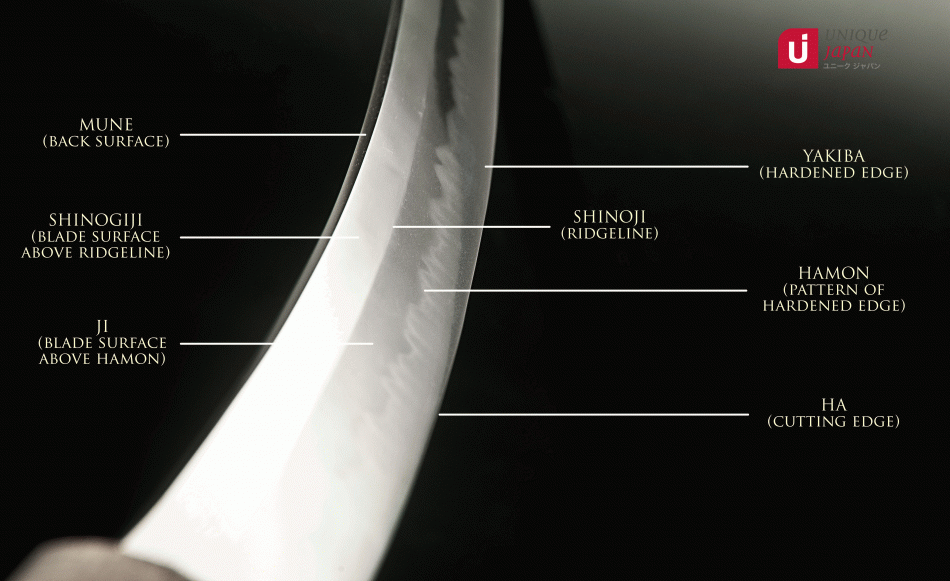
Broadly speaking, a hamon comes in three classifications; suguha (straight) , notare (gentle wave) and midare (irregular or wild).
Like the curvature of the sword, different patterns of the hamon emerged at different time periods. It is a very personal decision where the hamon “speaks” to the admirer. More often than not, clients prefer a wavy hamon, but there is definitely much to admire in a perfectly straight suguha hamon. A word of advice is not to be too quick to judge the hamon.
EXAMPLES OF HAMON PATTERNS
From Late Heian to Early Kamakura period (1000AD ~)
“suguha” or straight temper line
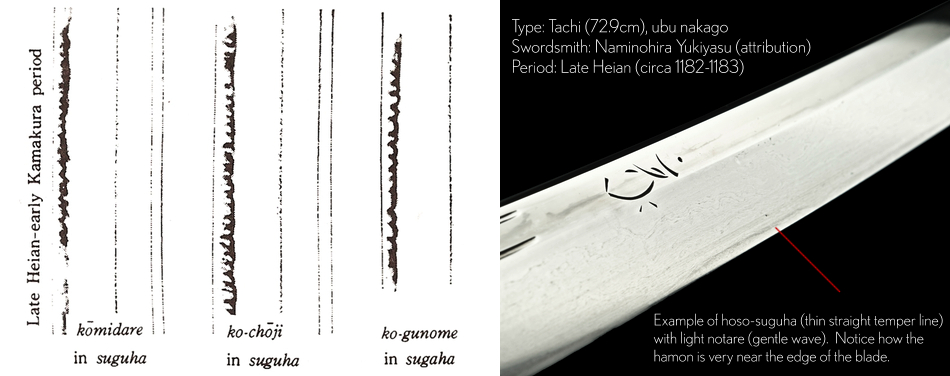
From Mid-Kamakura period (1200AD ~)
“choji” or clove temper line
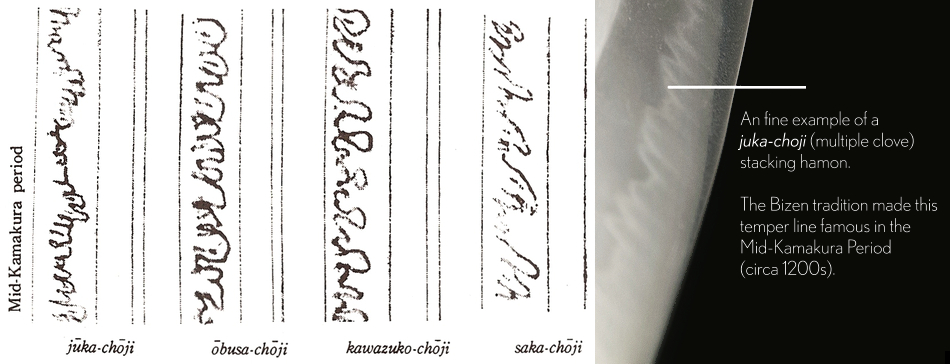
From Late-Kamakura period (1280AD ~)
“gunome” or wavy temper line
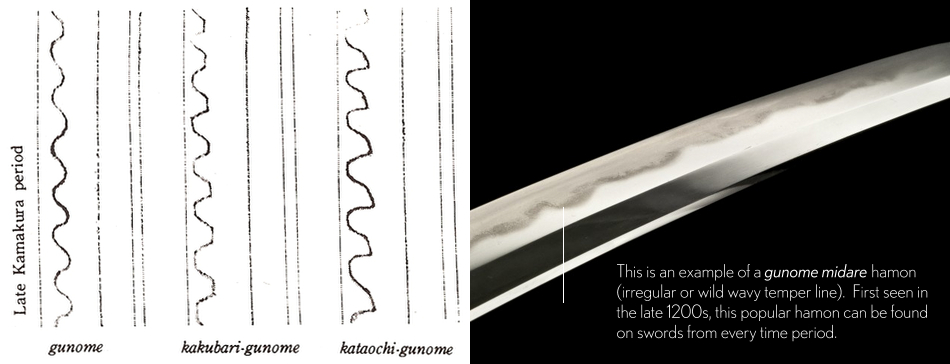
From Nambokucho period (1333AD ~)
“hitatsura” or full-temper line
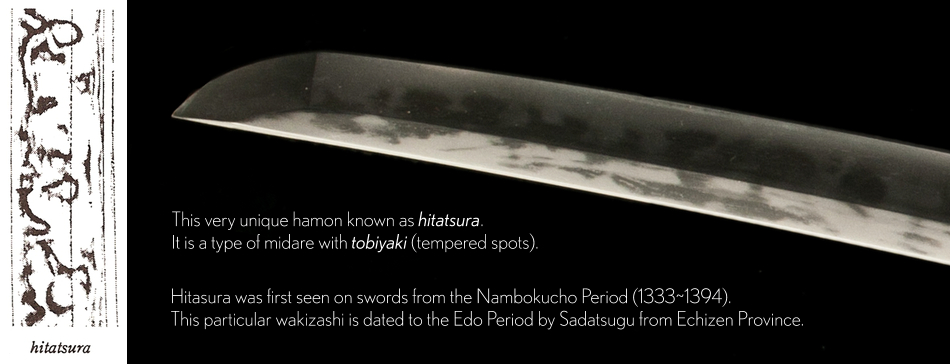
From Early Muromachi period (1400AD ~)
“complex gunome” wavy temper line
From Early Edo period (1600AD ~)
“sudare-ba” or bamboo-strip blind temper line
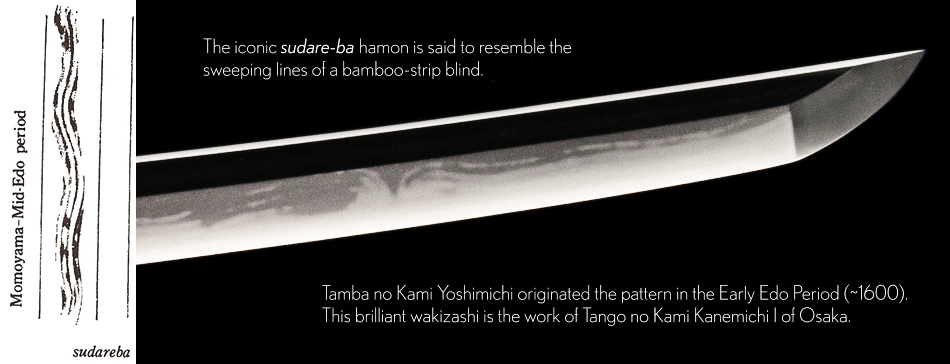
JIHADA (body or skin of the sword)
While the hamon gets all the attention, looking closely to the actual body of the sword is not only important, but also fascinating.
It’s important to keep in mind that a metallurgically well-made sword will exhibit harmony between the jihada (surface skin) and the hamon. It is just not possible to have a sword with a good hamon and a poor jihada, or vice versa.
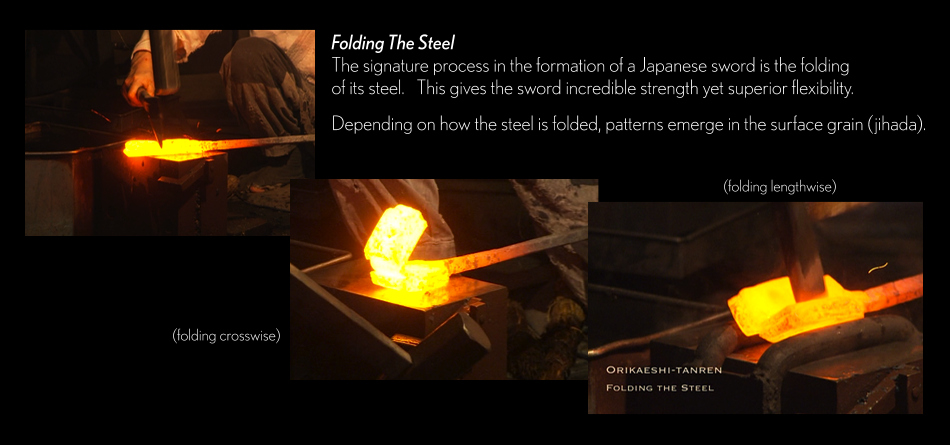
The laminations produced by the folding process during the manufacture of the blade result in a visible grain on the surface. The grain in the jigane (metal of the ground) can be one of several types, or a mixture of them.
The most widely found resembles the grain of a cut and planed piece of timber and is called itame (plank grain). A similar grain consisting of closed concentric rings is called mokume (wood grain).
Another type is called masame (true grain) which looks like a series of parallel lines, like the appearance of a log cut down the centre. More unusual formations include hitatsura (full temper) nashiji (pearskin), ayasugi (wavy adulating lines) and the famous konuka hada (rice bran), which one typically finds on swords from Hizen in Kyushu.
A word on the Swordsmith…
The swordsmith was an inspired artist and his workshop a sanctuary. Daily he commenced his craft with prayer and purification, or as the phrase was “the swordsmith committed his soul and spirit into the forging an tempering of the steel.”
The swordsmith was an inspired artist and his workshop a sanctuary. Daily he commenced his craft with prayer and purification, or as the phrase was “the swordsmith committed his soul and spirit into the forging an tempering of the steel.”
Every swing of the sledge, every plunge into water, every fiction on the grindstone, was a religious act of grand intention.
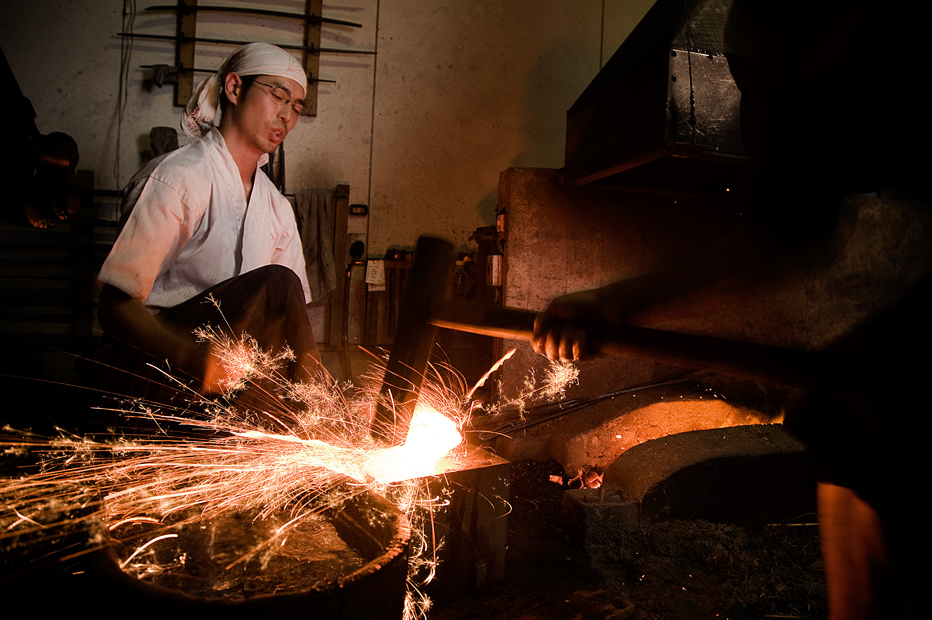
I have great admiration for swordsmiths. Above is photo taken by Jensen Walker (all rights reserved) at a forge in Chiba, Japan. It was quite the personal experience for all of us!!
NAKAGO (tang)
A sword’s tang (nakago) is never polished so as to help determine the age of the sword with decent accuracy. The nakago (tang) of koto (pre 1600) swords is thus very dark, almost black and soft in texture. The reason why the tang is so dark is because the steel has been left to rust for that much longer.
The nakago (tang) is an integral part of the whole sword, and its shape and size influence its cutting efficacy of the weapon. Since the Heian period (794-1185) when it was customary for smiths to sign their work, the tangs have been an invaluable guide to the whole history of sword-making in Japan. Name of the smith, and place and date of manufacture are found on many swords of earlier periods.
Many tangs are not signed, which is not necessarily a bad thing. In the Yamato tradition for example, finding a signed tang is likely finding the Holy Grail!
In some instances, an incredible amount of information is chiseled on the nakago.
For example, the image below reads: Kaga no Kuni Ju Tsujimura Denuemon Takahira Saku (Made by Takahira Denuemon in Kaga province).
The inside set of characters (南蛮鉄造之) reads Namban Tetsu Tsukuri (made using imported steel!)
For example, the image below reads: Kaga no Kuni Ju Tsujimura Denuemon Takahira Saku (Made by Takahira Denuemon in Kaga province).
The inside set of characters (南蛮鉄造之) reads Namban Tetsu Tsukuri (made using imported steel!)
In the Edo period, some of the best swordsmiths worked directly for powerful Daimyo (great families) and thus rarely signed the sword. Bottom line is to not dismiss a Japanese sword just because it is unsigned.
HORIMONO (Carvings and Grooves)
Horimono (groove carvings on blades) may be carved partially or wholly along the length of the finished blade, for both structural and aesthetic reasons. Pictorial carvings and inscriptions such as the deity Fudo Myo-o can be frequently found. Of ferocious aspect of bared fangs, Fudo Myo-o’s (Fire God) unmoving aspect represents the aspiration of the Samurai to remain calm during the heat of combat and even at the instant of impending death.
A common misconception is that a long “blood groove” found on a sword was solely produced to enable gasses (and blood) in the stomach to flow up or along the blade to ease it’s removal from a body.
While there may be ‘some’ truth this, the primary reason for having a groove helps to make the sword lighter and cut stronger as it takes on the cross-section shape and characteristics of an i-beam.
Point 6: SWORD MOUNTINGS (KOSHIRAE)
The image of a Japanese sword normally conjures up an image of a strikingly beautiful koshirae (mounting).
A koshirae (mountings) comprises of several handmade ornamental pieces that bring enormous character to the sword. The main pieces are a tsuba (guard), the kashira (pommel), the menuki (eye drawers on the hilt under the silk thread).
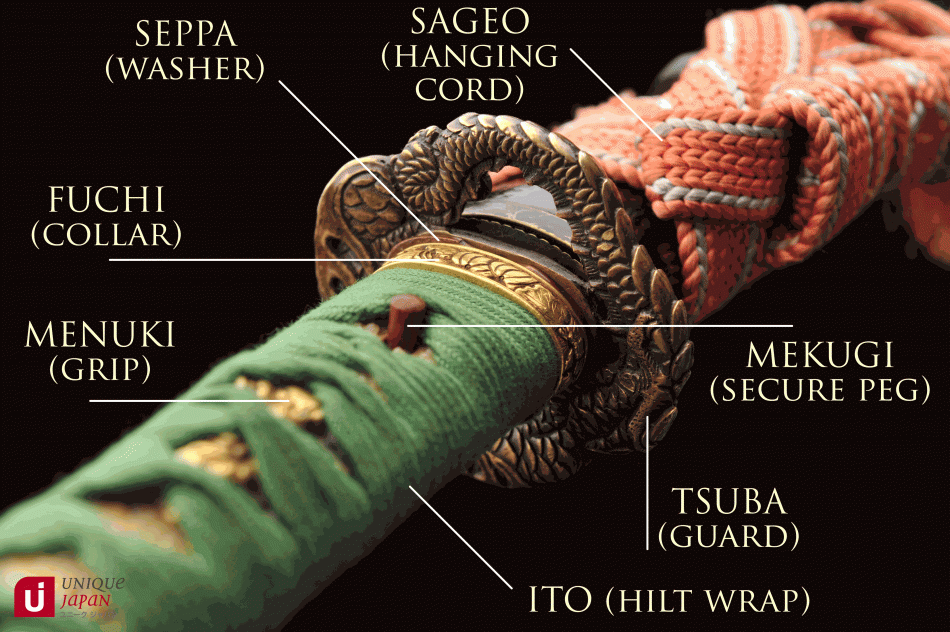
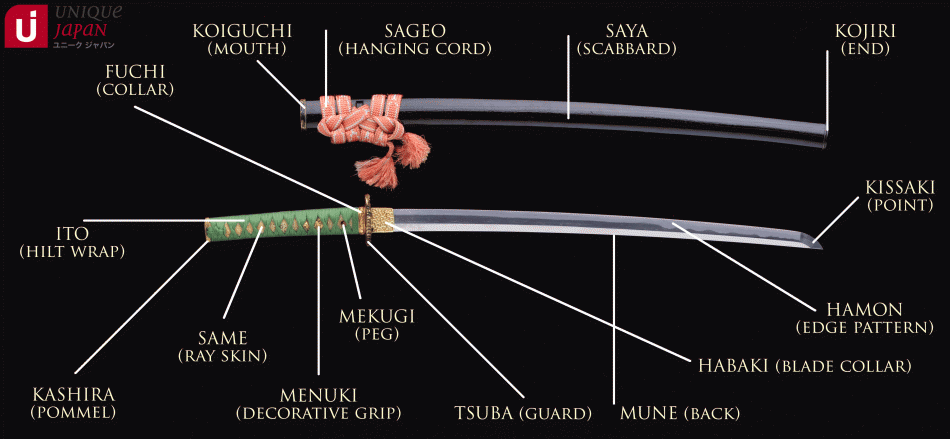
Just like the hamon, a swords koshirae tends to “speak” to the prospective owner. Whether the sword is ‘right’ or not is normally known in an instant.
“Many swords in existence today, including many valuable swords, are housed in a simple traditional shirasaya (white scabbard) and NOT in koshirae. Our clients sometimes are disappointed when a sword is not housed in a full koshirae, but the shirasaya is a like a humidor for an expensive cigar – it better preserves the steel as the magnolia wood absorbs fluid that might damage the steel.”
Think of the koshirae as daytime clothing and the shirasaya as the sword’s pajamas. The Samurai would remove the sword’s koshirae at night and house it in its shirasaya. In the morning, the Samurai would then place the koshirae. Even the Samurai was not impenetrable to fashion and would have many koshirae for a particular sword.
Build your Own Custom Made Koshirae!
A highly recommended project that many of our customers undertake it to invest in a quality sword in a shirasaya scabbard and then we produce a custom koshirae for them.
For this process, modern-day craftsmen and women using traditional methods of koshirae making will produce all the necessary parts of the koshirae.
Some elements such as the tsuba, menuki, and fuchi-kashira can be from the Edo period, so the end result is a wonderful blend of modern craftsmanship meeting traditional pieces that are hundreds of years old. Since the project is catered to our customers’ taste, a strong PERSONAL CONNECTION always gets delivered. It’s a wonderful adventure.
Point 7: NBTHK and NTHK-NPO CERTIFICATION PAPERS
Some Japanese swords have been certified by Nihon Bijutsu Token Hozon Kyokai (NBTHK, Society for the Preservation of the Japan Art Sword), or NTHK-NPO (Nihon Token Hozon Kai) both of which are trusted organizations responsible for screening and certifying judgement onto Japanese swords.
Certified swords are generally more expensive, but they offer a certain piece of mind. However, it’s VERY important that one doesn’t get too hung up if a sword is certified or not. A sword that is not certified does NOT at all imply that the sword is not genuine.
ALL SWORDS purchased from Unique Japan are guaranteed to be authentic. And EVERY piece, whether certified or not, has been legally registered with Japan’s Ministry of Cultural Affairs (which is, in a sense, an act of certification).
At the end of the day, certification from any organization is still only an opinion and the certification process does take time and money. Many experienced and knowledgeable sword collectors never feel a need to get their sword certified.
I’ve written two articles on this subject matter here that you may find to be helpful.
→ NBTHK Certification Paper Ranking for Japanese Swords
→ NTHK-NPO Certification Paper Ranking for Japanese Swords
→ NBTHK Certification Paper Ranking for Japanese Swords
→ NTHK-NPO Certification Paper Ranking for Japanese Swords
Next Steps
I hope you found this article helpful, and I thank you for taking the time to read it through. If owning a genuine Japanese Samurai sword is of interest to you and your family, we would be honoured to serve you.
To visitors in Japan…
If you have the pleasure of living in Japan or visiting the country, we recommend that you come to one of our upcoming sword shows or schedule a private VIP meeting with us.
VIP meetings are normally held near JR Ebisu station in Tokyo at a hired gallery space. We can also arrange visits to a company office, hotel, near the airport or at a private residence. We will arrange for a select number of Japanese swords that best match what your criteria.
To those exploring our collection online, be sure to download our catalogue of available swords here.
Be sure to become part of our VIP Email List as all catalogues are pre-sent to VIPs before they are released to the public.
We completely respect the fact it takes a HUGE leap of personal FAITH in us to commit to a particular sword given the reliance on photos and descriptions for such a highly valued item.
It is our PROMISE to address all your questions to the best of our ability. It’s important to us that you feel completely confident that the sword you choose (and that chooses you) is destined for you and your family.
You can also take reassurance that ALL swords from Unique Japan are GUARANTEED AUTHENTIC and come with a 3-DAY WORRY FREE inspection period upon arrival to your home.
Recent client testimonials:
 Pablo excels in customer service without limit to the date the purchase was made. If you have a question or problem, he will help answer it, or provide a solution. Conducting business with Pablo, extends beyond an investment. It will carry on into many happy years of customer satisfaction and peace of mind.
Pablo excels in customer service without limit to the date the purchase was made. If you have a question or problem, he will help answer it, or provide a solution. Conducting business with Pablo, extends beyond an investment. It will carry on into many happy years of customer satisfaction and peace of mind. When you purchase from Pablo your buying more than just a sword or knife, you’re getting peace of mind and gaining a friend and sensei in the art of samurai swords.

Jonah, Okinawa Japan
 To Whom It May Concern: In the Summer of 2013 I purchased an antique samurai sword through Pablo Kuntz and Unique Japan. This letter is a testimonial to the professional work and trustworthy nature of Pablo and Unique Japan.
To Whom It May Concern: In the Summer of 2013 I purchased an antique samurai sword through Pablo Kuntz and Unique Japan. This letter is a testimonial to the professional work and trustworthy nature of Pablo and Unique Japan.
 To Whom It May Concern: In the Summer of 2013 I purchased an antique samurai sword through Pablo Kuntz and Unique Japan. This letter is a testimonial to the professional work and trustworthy nature of Pablo and Unique Japan.
To Whom It May Concern: In the Summer of 2013 I purchased an antique samurai sword through Pablo Kuntz and Unique Japan. This letter is a testimonial to the professional work and trustworthy nature of Pablo and Unique Japan.As a repeat customer, I have no reservations recommending Pablo and Unique Japan to anyone who is considering these products. My enthusiastic endorsement is somewhat surprising even to myself, since I have never actually met Pablo nor any of his staff at Unique Japan in person. Making these purchases was a leap of faith that has been consistently rewarded, and I look forward to conducting more business with Pablo Kuntz and Unique Japan in the future.
Unlike what I imagine most Unique Japan customers to be like, I had no experience in antique swords and little to no experience with making substantial, international purchases. Throughout the process of reviewing the inventory, deciding on a sword, and then arranging and waiting for it to be delivered, Pablo remained unwaveringly patient and professional. My endless questions and ruminations never exhausted his seemingly endless patience, and his enthusiasm and expertise were an integral part of making conducting business with him both educational and enjoyable.

MCH, Northern California USA
Legal Exportation from Japan
Yes, it is completely legal to own a genuine antique Japanese sword (even those that are several hundreds of years old). Unique Japan specialises in all proper legal compliances so that swords can be exported from Japan. All required paperwork is provided free of charge for clients.
Unique Japan has safely sent well over 200 swords FROM Japan to immensely proud owners in the United States, Canada, Europe and around the world.
Thank You!
Again, THANK YOU for visiting and please feel free to share this page with friends who might be interested in discovering Japanese swords. If you would like to get in touch, feel free to contact us at anytime.
On behalf of myself and the team at Unique Japan, we look forward to serving you.
Pablo Kuntz, Founder of Unique Japan (click link for Bio)
Photos above:
(Left) Taken at the Okinawa Sword Show
(Right) Pablo Kuntz presents an information session on Japanese swords at the CLSA Japan Forum 9 (Hyatt Hotel, Roppongi)
(Left) Taken at the Okinawa Sword Show
(Right) Pablo Kuntz presents an information session on Japanese swords at the CLSA Japan Forum 9 (Hyatt Hotel, Roppongi)
Here below is a video clip from my appearance on Discovery Channel’s new TV series “Dealers”, where I presented two antique Samurai swords.
Above: In early 2014 I was approached by NHK Enterprises in Japan to take part in a 50-minute documentary on the fine art of Japanese sword polishing. A craft that truly deserves greater appreciation. I met renowned sword polisher Sasaki-sensei and his skilled apprentices, specifically Yuichi-san who worked hard on a beautiful Yasusada wakizashi that I submitted for polishing. The documentary was aired online globally on Sunday August 24th, 2014.
Reference Material
* “Cutting Edge: Japanese Swords in the British Museum” by Victor Harris.
** The Samurai Sword by Kohshyu Yoshida
*** Secrets of the Millionaire Mind by T. Harv Eker
* “Cutting Edge: Japanese Swords in the British Museum” by Victor Harris.
** The Samurai Sword by Kohshyu Yoshida
*** Secrets of the Millionaire Mind by T. Harv Eker
Popular Pages of Interest
→ 7 Points to Consider when Choosing your Japanese Sword
→ 5 Steps to Owning an Authentic Japanese Samurai Sword
→ Download catalogue of currently available Japanese swords
→ PARTS of a Japanese Sword and Mountings (High-quality images)
→ 7 reasons WHY I love Japanese swords
→ Resource Information on Japanese Swords
→ NBTHK Certification Paper Ranking for Japanese Swords
→ NTHK-NPO Certification Paper Ranking for Japanese Swords
→ 5 Steps to Owning an Authentic Japanese Samurai Sword
→ Download catalogue of currently available Japanese swords
→ PARTS of a Japanese Sword and Mountings (High-quality images)
→ 7 reasons WHY I love Japanese swords
→ Resource Information on Japanese Swords
→ NBTHK Certification Paper Ranking for Japanese Swords
→ NTHK-NPO Certification Paper Ranking for Japanese Swords





